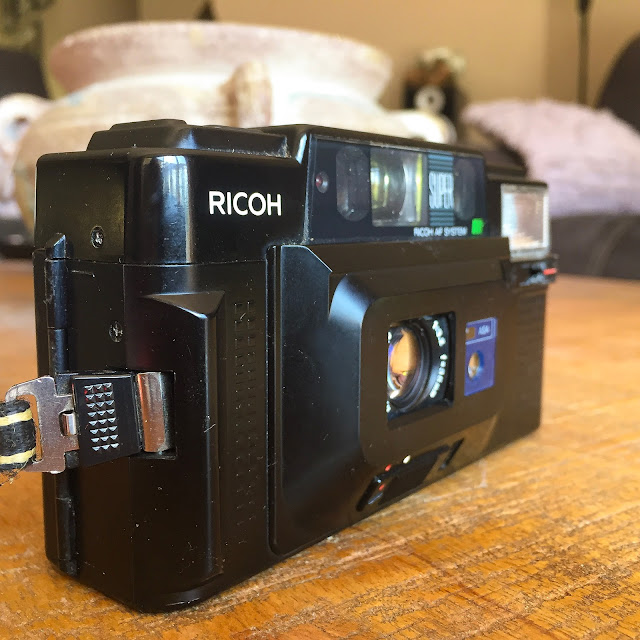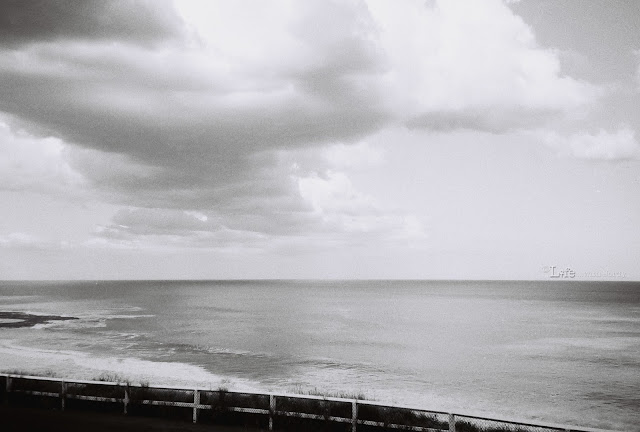Ricoh FF-3 Super AF 35mm Camera
So I was given another camera (won't hear me arguing!) A point and shoot that had belonged to my mother-in-law and was passed onto me because of my love of film photography and collecting vintage cameras.
I was not too sure if it worked at all when I first got it. The camera had obviously been dropped at some stage and the slide switch for the flash was broken. The switch is located on the front of the camera below the flash and is in an awkward position; when turning on the flash, the switch slides across and protrudes on the outside of the camera body. Makes it easier to get caught on things. Anyway, half of the slide piece was still intact and there was some slight cracking on the body in that area. There was no contact with any electric components and so the flash was history. Eventually, that slide piece came out somewhere and now there is just a gap in the front of the camera. However......
The rest of the camera worked fine and, honestly, I would never be in a position to use the flash with this camera anyway.
The camera was released by Ricoh in 1982 for AU$300 or so (in todays value, just under AU$1200). It comes with a Rikenon 35mm f3.5 lens which is amazingly sharp for a point and shoot of that era (5 elements and 5 groups). It has a slide cover over the lens. Not only does that protect the outer lens glass but it locks the shutter, which is good if you have a small camera bouncing around in your bag; no more surprise photos of your bag contents! It also has a manual ISO adjustment from 25-1000 so, if you wish to over or underexpose you can do so by adjusting the ISO setting.
Pushing down the shutter release button halfway will cause 3 icons to pop up in the viewfinder to show where your focus is sitting at. The icons indicate Portrait, Full Body or Landscape view. The viewfinder also has parallax marks to show the positioning of the subject and a warning light for camera shake (which is an indication of slow shutter speed and to turn on the flash!) A photo can be re-framed by pushing down the button half way to focus on the subject and then moving the camera to re-frame the photo.
The camera has an auto-wind on feature between shots and, at the end of the roll, pushing a button will wind the film back into the reel.
It also has a timer for those social page selfies!
I decided on using Fomapan Classic 100 Black & White film. This is a slow film at 100 ISO and has a surprising amount of grain for a low ISO film (even though the spec sheets describe it as a low grain, high resolution film!). Although I must say that the grain is not as bad when shot in a brighter situation rather than an overcast day. It offers a good range of tones and detail in shadows and highlights and has a wide latitude for exposure with a great classic look.
All Photos are Copyright ©Life with Jordy Photography
All Rights Reserved.
 |
| You can see the damaged flash slide switch in this photo. Eventually, the switch just slid off into nothingness . |
 |
| When viewing on the Blog, the grain doesn't appear as evident as it did in Lightroom for first viewing. |
 |
| The Rikonen lens still putting out some nice sharpness. |
 |
| My fav photo of the roll. Lovely crisp B&W tones and detail in the darker areas. |
 |
| The grain is apparent in this photo in the sky where the lens vignettes in the top corners. It does add a lovely classic film feel to the subject though. |
 |
| Despite the grain, the subject is still nice and sharp. I didn't bother cropping out the top of the hill! |















Comments
Post a Comment